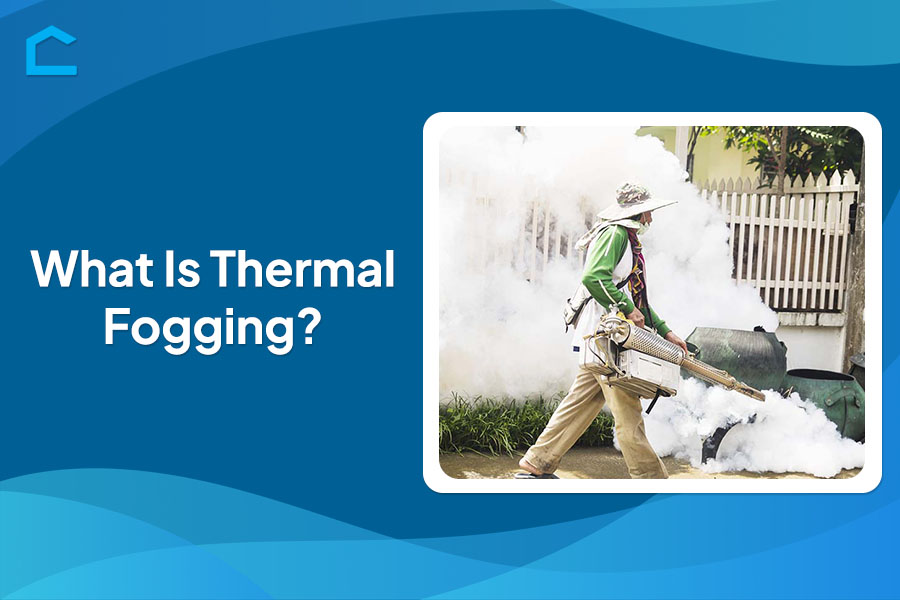What Is Thermal Fogging?

Innovative techniques continue to emerge in cleaning and restoration. Among these cutting-edge methods, thermal fogging stands out as a powerful solution that has gained significant attention in recent years. But what is thermal fogging, and what does it clean?
As we dive into the world of thermal fogging, we’ll explore its applications, benefits, and the science behind this intriguing technology. Join us as we uncover the potential of this remarkable technique and discover how it’s changing the landscape of cleaning and restoration practices.

Source: shutterstock.com / Photo Contributor: Deere Kumphaitoon
What Is Thermal Fogging?
Thermal fogging is a thorough disinfection method that harnesses heat to create a fog of extremely fine particles from a disinfecting solution. The basic principle behind thermal fogging is straightforward: by heating a specialized disinfectant solution, it vaporizes into tiny particles that remain suspended in the air for a period. This vapor or fog is then dispersed throughout the targeted area using specialized equipment.
Due to the ultra-fine nature of the particles and the heat-driven propulsion, thermal fogging allows the fog to penetrate deeply into affected areas. It can sanitize areas such as cracks, crevices, and other hard-to-reach spots typically missed by conventional cleaning methods.
This deep penetration ensures thorough disinfection and contributes to the effectiveness of the thermal fogging process in combating contaminants and pathogens. It is widely employed in healthcare facilities, food processing plants, hotels, and public transportation to eradicate pathogens and maintain stringent sanitization standards.
What Is Thermal Fogging Used For?
Odor and pest control
Thermal fogging excels at odor removal. It uses a dry fog to disperse deodorizing agents. This fog penetrates deeply into porous materials and hard-to-reach spaces where odors originate, making it effective for eliminating stubborn smells like lingering smoke odors after fires.
The fog can also carry insecticides and pesticides, allowing for comprehensive pest control by accessing the cracks and crevices where insects breed and nest. The permeating fog leaves no odor source or pest-hiding spot untreated.
Mold remediation and sensitive environment disinfection
Thermal fogging isn’t just for pest control—it’s crucial in mold remediation, too. The fog penetrates mold-infested areas by transporting antimicrobial agents, potentially killing spores and halting further growth. This method addresses mold problems at their source, going beyond surface removal.
Additionally, thermal fogging proves invaluable in disinfecting sensitive environments like cleanrooms, labs, and food processing facilities. Unlike liquid disinfectants that can pose contamination risks, the dry fog method sanitizes every surface thoroughly and safely.
Benefits of Thermal Fogging
Unmatched coverage and efficiency
Thermal fogging ensures comprehensive treatment of all areas. The dense fog penetrates even the smallest cracks, crevices, and confined spaces, reaching places traditional cleaning methods can’t. As the fog particles permeate every corner, no spot is left untreated.
This unmatched coverage comes with impressive efficiency. Unlike labor-intensive manual processes, thermal fogging can quickly treat large volumes and expansive areas. It saves significant time while ensuring thorough disinfection or deodorization. If you need full coverage for your facility, thermal fogging might be an ideal solution.
Fast deodorization and disinfection
For deodorization, the odor-neutralizing fog rapidly eliminates harsh smells at their source. It can permeate porous materials to remove deeply-set odors, such as smoke, providing much faster relief than other deodorizing methods.
Thermal fogging is also unparalleled for disinfection. The disinfectant particles coat every surface in the treated space, ensuring no area is left uncleaned or untreated.
This method easily disinfects and sanitizes facilities like warehouses, convention centers, and buildings. No other method matches its combination of speed and comprehensive coverage.
Types of Thermal Foggers
Several types of thermal foggers exist, each suited to different applications and environments. Portable thermal foggers are small, lightweight, and easy to carry.
They are ideal for indoor use, small outdoor areas, and localized treatments. These foggers typically use propane or butane as a fuel source, making them convenient for quick and targeted applications without needing an electrical outlet.
On the other hand, truck-mounted thermal foggers are larger units designed to be mounted on trucks or other vehicles. These foggers are suitable for treating large outdoor areas such as agricultural fields, parks, and public spaces. They are often powered by the vehicle’s or a separate gasoline engine.
Electric thermal foggers utilize electricity to generate the heat needed to create the fog. These are particularly suitable for indoor use where a consistent power source is available, such as in warehouses and large buildings. Electric foggers provide a reliable and steady output, making them efficient for prolonged use in controlled environments.
Moreover, gasoline-powered thermal foggers use gasoline to produce the necessary heat for fogging. These versatile foggers can be used indoors and outdoors, especially in areas where electrical power supply may not be readily available. The gasoline fuel tank allows for extended operation.

Source: shutterstock.com / Photo Contributor: Pair Srinrat
Safety Considerations
Importance of professional handling
Thermal fogging equipment releases a very fine mist that can contain hazardous chemicals. If not handled properly, you might risk health issues from inhaling fumes or from skin and eye exposure. It might also damage your property if surfaces are overexposed or if incompatible materials are treated.
To avoid these dangers, it’s crucial to have thermal fogging done by trained and certified professionals. These professionals undergo rigorous training on safe operating procedures and chemical regulations, and their certification ensures they are competent in thermal fogging work.
Professionals are trained in the proper techniques for equipment setup, operation, and maintenance. They also understand the chemical compositions and reactivity of the substances used, which is vital for safe and effective fogging.
Benefits of hiring certified professionals
By hiring certified thermal fogging professionals, you eliminate several risks. These might include health problems, property damage, and regulatory violations resulting from improper equipment usage.
The professionals understand which chemicals are approved and how to apply them safely on different materials. They also take prescribed precautions, such as wearing personal protective equipment. Attempting thermal fogging without this specialized knowledge and skill set might lead to hazardous situations.
That said, we must emphasize that thermal fogging must be left to certified experts for safe and effective application. Their services provide peace of mind and liability protection, helping you avoid costly mistakes that could jeopardize safety or property conditions.

Source: shutterstock.com / Photo Contributor: Pair Srinrat
Conclusion
Thermal fogging is a powerful and versatile solution. It addresses comprehensive disinfection, deodorization, mold remediation, and pest control needs in residential, commercial, and industrial settings.
Its ultra-fine disinfecting fog allows unmatched penetration into even the smallest cracks and crevices, which are unreachable through conventional cleaning methods. So, what is thermal fogging? It is a process that uses heat to vaporize disinfecting solutions into an ultra-fine mist capable of coating every surface.
However, the equipment uses chemical compounds, which requires handling by trained professionals. This mitigates risks of health hazards, property damage, and regulatory violations.
When deployed by certified experts following strict safety protocols, thermal fogging eradicates pathogens, neutralizes odors, and remediates mold. So, harness the power of thermal fogging for thorough and effective decontamination.
Safeguard your environment with expert care and precision!
